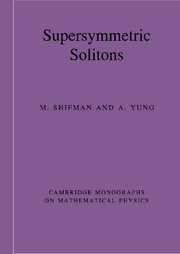Book contents
- Frontmatter
- Contents
- Acknowledgments
- List of abbreviations
- 1 Introduction
- I SHORT EXCURSION
- II LONG JOURNEY
- Introduction to Part II
- 4 Non-Abelian strings
- 5 Less supersymmetry
- 6 Non-BPS non-Abelian strings
- 7 Strings on the Higgs branches
- 8 Domain walls as D-brane prototypes
- 9 Wall-string junctions
- 10 Conclusions
- Appendix A Conventions and notation
- Appendix B Many faces of two-dimensional supersymmetric CP(N – 1) model
- Appendix C Strings in N = 2 SQED
- References
- Index
- Author index
5 - Less supersymmetry
from II - LONG JOURNEY
Published online by Cambridge University Press: 28 July 2009
- Frontmatter
- Contents
- Acknowledgments
- List of abbreviations
- 1 Introduction
- I SHORT EXCURSION
- II LONG JOURNEY
- Introduction to Part II
- 4 Non-Abelian strings
- 5 Less supersymmetry
- 6 Non-BPS non-Abelian strings
- 7 Strings on the Higgs branches
- 8 Domain walls as D-brane prototypes
- 9 Wall-string junctions
- 10 Conclusions
- Appendix A Conventions and notation
- Appendix B Many faces of two-dimensional supersymmetric CP(N – 1) model
- Appendix C Strings in N = 2 SQED
- References
- Index
- Author index
Summary
Let us move towards less supersymmetric theories. In this chapter we will review non-Abelian strings in four-dimensional gauge theories with N = 1. In Chapter 6 we will deal with N = 0.
As was discussed in the Introduction to Part II, the Seiberg-Witten mechanism of confinement [2, 3] relies on a cascade gauge symmetry breaking: the non-Abelian gauge group breaks down to an Abelian subgroup at a higher scale by condensation of the adjoint scalars, and at a lower scale the Abelian subgroup breaks down to a discrete subgroup by condensation of quarks (or monopoles, depending on the type of vacuum considered). This leads to formation of the ANO flux tubes and ensures an Abelian nature of confinement of the monopoles (or quarks, respectively). The gauge group acting in the infrared, where the confinement mechanism becomes operative, is Abelian.
On the other hand, non-supersymmetric QCD-like theories as well as N = 1 SQCD have no adjoint scalars and, as a result, no cascade gauge symmetry breaking occurs. The gauge group acting in the infrared is non-Abelian. Confinement in these theories is non-Abelian. This poses a problem of understanding confinement in theories of this type. Apparently, a straightforward extrapolation of the Seiberg-Witten confinement scenario to these theories does not work.
The discovery of the non-Abelian strings [130, 131, 132, 133] suggests a novel possibility of solving this problem.
- Type
- Chapter
- Information
- Supersymmetric Solitons , pp. 142 - 170Publisher: Cambridge University PressPrint publication year: 2009



